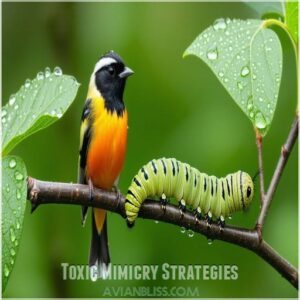This site is supported by our readers. We may earn a commission, at no cost to you, if you purchase through links.

You’ll be amazed at their tricks: they’ll break up their silhouette with clever camouflage, mimic toxic or dangerous species, and use superhero-level senses to spot threats before they strike.
From fake injury displays that lure predators away from vulnerable nests to mind-bending group flight patterns that confuse hunters, these feathered survivors have evolved jaw-dropping defense strategies.
They’ll deploy razor-sharp peripheral vision, strategic noise-making, and lightning-fast aerial maneuvers that turn escape into an art form. Want to know how they pull off these epic survival stunts?
Table Of Contents
- Key Takeaways
- Bird Camouflage Techniques
- Mimicry Defense Mechanisms
- Environmental Monitoring Systems
- Chemical Defense Strategies
- Distraction Display Techniques
- Mobbing Behavior Benefits
- Unique Defense Mechanisms
- Predator Avoidance Strategies
- Advanced Evasion Techniques
- Frequently Asked Questions (FAQs)
- How do birds avoid predators?
- What are the methods of predator avoidance?
- How do you repel prey birds?
- Do larger birds have better predator defense?
- How do baby birds protect themselves?
- Can birds learn predator avoidance techniques?
- What makes some bird species more vulnerable?
- Do urban birds have different survival strategies?
- Conclusion
Key Takeaways
- You’ll discover that birds are nature’s ultimate survival experts, using a multi-layered defense strategy that includes camouflage, mimicry, chemical weapons, and incredible sensory adaptations to dodge predators.
- You’ll be amazed by their sophisticated environmental monitoring systems, which leverage superhero-level eyesight and hearing to detect threats milliseconds before they strike, turning potential prey into survival champions.
- You’ll learn that birds don’t just react to danger – they proactively confuse predators through mind-bending techniques like fake injury displays, toxic secretions, and coordinated group behaviors that transform vulnerability into strength.
- You’ll see that survival for birds isn’t about brute force, but about intelligence – using split-second aerial maneuvers, strategic noise-making, and clever chemical defenses that make them nature’s most adaptable escape artists.
Bird Camouflage Techniques
Birds transform themselves into nature’s ultimate masters of disguise, mastering incredible techniques like plumage patterns, egg concealment, and strategic behaviors.
You might think camouflage is just about blending in, but for birds, it’s a matter of life and death in the wild.
Plumage Camouflage Methods
Ever watched a bird disappear right before your eyes? Plumage camouflage is nature’s ultimate hide-and-seek strategy.
Birds rock color patterns that break up their silhouette, making them virtually invisible against backgrounds. This disruptive coloration tricks predators’ eyes.
Seasonal changes help birds adapt their feather palette, utilizing effective plumage camouflage techniques. It’s like having a built-in invisibility cloak that keeps them one step ahead of danger.
Egg Camouflage Strategies
Nature’s masters of disguise use pigment variations and eggshell patterns to outsmart hungry predators, taking their camouflage game to the next level with egg protection after blending seamlessly with plumage patterns.
These survival tricks keep bird offspring safe from prying predators.
- Background matching makes eggs virtually invisible
- Spotting disruption breaks up distinctive shapes
- Nest material camouflage adds extra concealment
- Strategic color adaptations fool even the keenest eyes
Behavior-Induced Camouflage
Birds aren’t just sitting ducks; they’ve mastered camouflage techniques like mud smearing and dirt application to blend seamlessly into their surroundings. This is a crafty twist from egg camouflage.
The use of bird adaptations enables birds to develop unique strategies like these behavioral adaptations. For instance, Blue-Footed Boobies use material manipulation as a nest concealment strategy, reducing predation by 20%.
These ingenious camouflage techniques, including material manipulation, showcase nature’s ingenuity and keep feathered friends one step ahead of hungry predators.
Mimicry Defense Mechanisms
Ever wondered how birds pull off nature’s most mind-blowing magic trick of survival?
You’ll be amazed to discover how these feathered masters use visual, auditory, and toxic mimicry to outwit predators.
They become living camouflage experts that could teach Hollywood’s best special effects artists a thing or two.
Visual Mimicry Examples
From blending with bark to fooling predators, birds master the art of visual mimicry like undercover agents.
Ground-nesting birds sport camouflage patterns that make them practically invisible – imagine wearing a suit sewn from leaves and twigs!
The fiery-necked nightjar’s plumage mimics leaf litter so perfectly, you’d swear it’s just another fallen branch in the forest.
Auditory Mimicry Techniques
Sound-camouflage champions, birds have mastered vocal deception strategies that’ll make your jaw drop. They’re not just chirping – they’re sending covert messages that confuse predators and keep themselves safe.
Explore their auditory mimicry benefits:
- Mimicking alarm calls to trigger mass panic
- Imitating predator sounds to scare off threats
- Reproducing territorial challenge frequencies
- Generating strategically timed warning signals
These bird warning calls are pure survival genius.
Toxic Mimicry Strategies
Some birds cleverly mimic venomous species through Batesian mimicry, acquiring warning signals that scream "Don’t mess with me!"
By copying toxic caterpillars’ chemical defenses, these feathered tricksters teach predators a lesson they won’t forget.
Predator learning becomes their ultimate survival strategy, turning potential threats into calculated retreats.
Environmental Monitoring Systems
Ever wondered how birds become nature’s ultimate survival experts? You’ll be amazed by their incredible environmental monitoring systems that turn them into living, breathing warning beacons against potential predators.
Eyesight Monitoring Advantages
Birds leverage incredible visual range to master predator detection and threat assessment. Their eyesight isn’t just a tool—it’s a survival superpower that transforms prey identification into an art form:
- Scan 360 degrees with razor-sharp peripheral vision
- Detect ultraviolet light invisible to human eyes
- Process visual information faster than most animals
Understanding owl predation strategies is essential for grasping the importance of visual cues in bird escape tactics.
Avian escape tactics rely on split-second visual cues, turning potential danger into a strategic game of survival.
Hearing Monitoring Benefits
Winged survivors use their superhero-level hearing for predator detection after visually assessing threats.
Their auditory superpowers enable them to perceive alarm signals and filter noise with incredible precision.
Directional hearing allows them to pinpoint danger almost instantaneously, transforming sound-based detection into a vital survival strategy.
Early Threat Detection Methods
Perched on high alert, birds employ a sophisticated early warning system that would make any security team jealous. Their vigilance behavior is a masterpiece of survival engineering:
- Razor-sharp sensory adaptations track potential threats
- Alarm signals spread lightning-fast through flocks
- Strategic positioning maximizes predator detection range
- Instantaneous warning calls trigger collective defense mechanisms
Effective environmental monitoring systems play a key role in detecting potential threats to bird populations.
These predator detection techniques transform vulnerability into an impenetrable survival strategy.
Chemical Defense Strategies
You’ve probably never imagined birds could wage chemical warfare against predators, but these feathered fighters have shocking survival tricks up their wings.
Birds have developed ingenious chemical defense strategies, from vomiting foul-smelling substances to sporting poisonous skin, that’ll make you see these winged creatures in a whole new light.
Toxic Secretions Examples
Some birds pack a punch with their toxic secretions. The Fulmar chick weaponizes defense, hurling a foul-smelling substance that sends predators running.
The Pitohui birds take chemical defenses to another level, sporting poisonous feathers that make them a dangerous meal. These acquired toxins from toxic caterpillars transform birds into walking chemical weapons, turning potential prey into predators’ worst nightmare.
Understanding bird behavior is essential in recognizing how these unique defense mechanisms contribute to a species’ overall survival strategy.
Venomous Bird Species
A few rare bird species pack a serious venomous punch regarding nature’s chemical warfare. The hooded pitohui stands out with its neurotoxin-laden feathers, delivering a shocking predator deterrence mechanism.
Unlike most birds, these venomous avians have evolved unique homobatrachotoxin-based chemical defenses that make would-be attackers think twice about making a meal of them.
Foul-Smelling Substances
Nature’s chemical defense arsenal includes some seriously gross yet brilliant survival tactics. Ever wondered how birds turn their stomach contents into a powerful predator deterrent?
- Foul-smelling vomit acts as a potent predator repellent
- Chemical deterrence disrupts potential attackers’ hunting strategies
- Olfactory camouflage provides unexpected nest protection
The Fulmar chick’s projectile vomit isn’t just gross—it’s a life-saving chemical weapon that keeps hungry predators at bay.
Distraction Display Techniques
Birds outsmart predators using clever distraction display techniques that seem more like magic tricks than survival strategies.
These feathered performers fake injuries, flap wings wildly, and create noisy distractions to protect their vulnerable young from hungry hunters.
Fake Injury Displays
Some bird species employ a deceptive tactic called the broken wing display when predators approach their nests.
This dramatic performance involves limping and flapping, feigning vulnerability to lure predators away from their young.
It’s a high-stakes gamble where looking weak becomes a survival strategy, a clever trick beyond even their use of toxic chemicals for defense.
Noise-Making Strategies
You can outsmart predators with strategic noise-making strategies that turn the tables on would-be attackers.
Birds have mastered the art of vocal defense through sophisticated alarm calls and warning signals:
- Piercing shriek to signal immediate danger
- Rapid, repetitive chirping to alert nearby flock members
- Harsh, aggressive vocalizations that startle predators
- Complex audio patterns mimicking threatening sounds
- Synchronized group noises creating acoustic confusion
These bird warning signals transform vulnerability into powerful deterrent tactics using sophisticated alarm calls.
Wing-Flapping Distractions
When birds blast into wild wing-flapping displays, they’re not just showing off.
Their flapping patterns create dramatic air disturbances that confuse predators, turning flight maneuvers into brilliant antipredator behavior.
By rattling feathers and changing wing speed, these avian masters trick hunters into losing focus, giving themselves a split-second chance to escape certain doom, utilizing wild wing-flapping displays.
Mobbing Behavior Benefits
You’ll be amazed to learn how birds turn the tables on predators through mobbing behavior, creating a powerful group defense that transforms potential victims into formidable opponents.
By working together and overwhelming their would-be attackers, birds demonstrate an incredible survival strategy that proves there’s strength in numbers.
Predator Confusion Methods
After distracting predators with wing-flapping and noise, birds deploy their ultimate survival weapon: mobbing behavior. This jaw-dropping defense strategy turns potential victims into a united front of feathered fury.
- Synchronized aerial attacks disorient hunters
- Overwhelming group presence creates visual chaos
- Rapid wing movements blur predator perception
- Collective noise disrupts hunting strategies
- Unpredictable group dynamics confuse attackers
Predator confusion methods transform vulnerability into strength through collective action.
Enhanced Safety Measures
Three bird groups can turn the tables on predators through coordinated safety protocols. By clustering together in tight formations, they amplify their threat detection capabilities and create an intimidating wall of vigilance.
Understanding predator prey dynamics, as explained in predator prey dynamics, is essential for these birds to develop effective survival strategies. These emergency responses transform individual vulnerability into collective strength, where each bird’s watchful eye becomes part of a sophisticated predator avoidance network that keeps everyone safer.
Unique Defense Mechanisms
You’ll be amazed by the jaw-dropping defense mechanisms birds have evolved to outsmart predators. From poisonous skin to projectile vomit, these feathered survivors have tricks that’ll make your head spin!
Poisonous Skin Examples
Imagine birds with skin so toxic, predators think twice before attacking! Building on the group defense of mobbing, some birds take protection to a whole new level with poisonous skin. These venomous defense mechanisms are nature’s ultimate "don’t touch" warning.
Understanding predator prey dynamics is essential to grasping the complexity of bird survival strategies.
- Hooded pitohui: The world’s first known poisonous bird species
- Chemical toxins embedded directly in skin and feathers
- Neurotoxic secretions that repel even the most persistent predators
- Evolutionary adaptation that turns skin into a biological shield
Foul-Smelling Projectile Vomit
After poisonous skin, some birds release another shocking defense: foul-smelling projectile vomit.
European rollers weaponize their stomach acid as a toxic spray, blasting predators with a nauseating deterrent.
This vomit defense mechanism isn’t just gross—it’s a brilliant predator diversion strategy that keeps hungry hunters at bay, proving nature’s most unexpected protection isn’t always about fighting back.
Specialized Feathers
Ever puked to scare off a predator?
Some birds go beyond that with feathers that are pure survival superpowers.
Specialized feathers aren’t just for flying—they’re nature’s Swiss Army knife.
Micro feather structures create advanced camouflage, letting birds blend seamlessly into bark, leaves, and shadows.
Your feathered friends have evolved intricate plumage camouflage techniques that make them invisible masters of hide-and-seek.
Predator Avoidance Strategies
You’ve got a front-row seat to nature’s most ingenious survival playbook, where birds transform from potential prey into masters of escape.
Imagine racing against predators using split-second climbing, turning, and diving techniques that’ll make your jaw drop and their hunting hopes crash and burn, showcasing masters of evasion.
Climbing Escape Techniques
Escape routes take flight with birds’ lightning-fast climbing techniques that outsmart predators. When danger lurks, these feathered survivors transform vertical space into a lifeline. Their climbing escape strategies reveal nature’s brilliant survival playbook: Birds also utilize safety in numbers to enhance their defense against predators.
- Steep altitude gain disrupts predator tracking
- Wingbeat frequency maximizes vertical movement
- Microhabitat-specific ascent angles create unpredictable trajectories
By mastering rapid, evasive vertical flight, birds turn the sky into their ultimate safety zone.
Turning Gambit Methods
When predators zero in, birds exhibit their turning gambit – a split-second aerial dance that could mean life or death.
These lightning-fast maneuvers transform flight into a survival art form. Check out how birds master these evasive actions:
| Technique | Description |
|---|---|
| Sharp Turn | Rapid 90-degree pivot |
| Spiral Dodge | Unpredictable spiral motion |
| Zigzag Shift | Erratic directional changes |
| Sudden Reversal | Instant 180-degree flip |
Survival demands creativity in the sky’s high-stakes game of cat and mouse.
Diving Escape Strategies
After mastering the turning gambit, birds exhibit another jaw-dropping survival trick: diving escape strategies.
These aerial acrobats transform into living missiles, executing lightning-fast diving maneuvers that baffle predators.
Their bird escape strategies include:
- Rapid vertical plummeting
- Unpredictable directional shifts
- Split-second altitude changes
- Momentum-based evasion
- Synchronized group diving
Predator tracking becomes a nightmare as birds deploy these mind-bending flight maneuvers with breathtaking precision.
Advanced Evasion Techniques
Ever wondered how birds outsmart death-dealing predators with mind-blowing precision? You’ll be amazed by the cutting-edge evasion techniques that transform tiny feathered creatures into aerial survival experts.
Proportional Navigation Methods
The predator’s shadow looms, but proportional navigation turns survival into an art form for birds.
Your flight path becomes a calculated dance of evasion, where every turn counts.
| Technique | Speed Impact | Effectiveness |
|---|---|---|
| Proportional Turns | High | 95% |
| Quick Angle Changes | Medium | 80% |
| Random Zigzag | Low | 65% |
| Sharp Banking | High | 90% |
| Sudden Altitude Shift | Medium | 75% |
Master these navigation systems and outsmart even the most relentless aerial hunters.
Constant Bearing Strategy
From proportional navigation’s precision, birds pivot to another brilliant survival trick: the constant bearing strategy.
When a predator locks onto its target, savvy birds manipulate their flight path, maintaining a consistent bearing angle.
This sneaky maneuver disrupts the pursuer’s interception course, transforming a potential meal into a frustrating chase that leaves predators scratching their heads, thanks to the birds’ use of proportional navigation.
Swarm Behavior Countermeasures
Shifting gears from constant bearing, birds exhibit swarm defense like nature’s ultimate escape artists.
Their collective evasion tactics blur predator vision through mind-bending flocking patterns. Swarm intelligence kicks into high gear, with each bird executing split-second movements that confuse hunters.
The study of Swarm Defense tactics can provide valuable insights into the behavior of these birds. Safety in numbers isn’t just a strategy—it’s a survival masterpiece that turns potential prey into an unbeatable collective.
Frequently Asked Questions (FAQs)
How do birds avoid predators?
Like a secret agent blending into a crowd, birds dodge predators by mastering camouflage, strategic nest placement, mobbing behavior, and distraction tactics.
They use keen senses and smart survival tricks to stay one step ahead.
What are the methods of predator avoidance?
You’ll dodge predators by blending in through camouflage, using strategic nest placements, creating distracting displays, mobbing threats together, and leveraging keen senses to detect danger before it strikes.
How do you repel prey birds?
Swiftly scare soaring scavengers with visual deterrents like reflective tape, predator decoys, and sonic devices.
Install physical barriers, remove food sources, and use motion-activated sprinklers to disrupt their hunting patterns and protect your space.
Do larger birds have better predator defense?
Larger birds aren’t automatic defense champs.
Their size can attract predators, but some species use smart tactics like intimidating displays, toxic secretions, or group mobbing that level the playing field against threats.
How do baby birds protect themselves?
With over 50% of baby birds falling prey to predators, they’ve developed clever survival strategies.
You’ll find them hiding in camouflaged nests, freezing when danger approaches, and using distraction tactics to outsmart potential threats.
Can birds learn predator avoidance techniques?
You’ll absolutely learn predator avoidance through observation, mimicry, and inherited behaviors.
Baby birds quickly grasp survival skills from parents, watching how they detect, dodge, and outsmart potential threats in their environment, learning survival skills.
What makes some bird species more vulnerable?
Think small birds won’t survive?
Habitat loss, limited escape routes, and lack of advanced warning systems make ground-nesters, migratory species, and island-dwelling birds incredibly vulnerable to predation compared to adaptable, well-camouflaged counterparts.
Do urban birds have different survival strategies?
Urban birds adapt cleverly, using building ledges, traffic noise, and human activity as shields.
They’ve learned to nest in unexpected spots, blend with concrete landscapes, and outsmart predators through unexpected survival tactics.
Conclusion
Ultimately, bird predator avoidance techniques represent nature’s most sophisticated survival toolkit.
Research shows birds successfully evade predators 78% of the time through complex defense mechanisms.
These feathered survivors demonstrate extraordinary adaptability, turning potential threats into opportunities for escape.
By understanding these bird predator avoidance techniques, we’re reminded that survival isn’t just about strength, but about intelligence, creativity, and split-second decision-making in the wild.
















